Immunobiological Characteristics of the Attenuated African Swine Fever Virus Strain Katanga-350
Abstract
:1. Introduction
2. Materials and Methods
2.1. Viruses and Cells
2.2. Animal Experiments and Ethics Statement
2.3. Preparation of Peripheral Blood Leukocytes
2.4. Assessment of Hemadsorbtion Inhibition (HAdI)
2.5. Sample Collection
2.6. Polymerase Chain Reaction (PCR)
2.7. DNA Sequencing and Analyses
2.8. Detection of Anti-ASFV Antibodies
2.9. Clinical Evaluation and Sampling
2.10. Statistical Analysis
3. Results
3.1. Nucleotide Sequencing and Phylogenetic Analysis of the Strain Katanga-350
3.2. Serotyping of ASFV Strains, Katanga, Katanga-350 and Stavropol 08/01
3.3. Protection of Pigs Inoculated with Katanga-350 Strain from Challenge with Virulent ASFV Isolates
3.4. Detection of the Viral DNA
3.5. Antibody Response in Host Animals
4. Discussion
Author Contributions
Funding
Institutional Review Board Statement
Informed Consent Statement
Data Availability Statement
Acknowledgments
Conflicts of Interest
References
- Blome, S.; Franzke, K.; Beer, M. African Swine Fever—A Review of Current Knowledge. Virus Res. 2020, 287, 198099. [Google Scholar] [CrossRef]
- Revilla, Y.; Pérez-Núñez, D.; Richt, J.A. Chapter Three—African swine fever virus biology and vaccine approaches. In Advances in Virus Research; Kielian, M., Mettenleiter, T.C., Roossinck, M.J., Eds.; Academic Press: Cambridge, MA, USA, 2018; Volume 100, pp. 41–74. [Google Scholar]
- Montgomery, R.E. On A Form of Swine Fever Occurring in British East Africa (Kenya Colony). J. Comp. Pathol. Ther. 1921, 34, 159–191. [Google Scholar] [CrossRef] [Green Version]
- Lu, Y.; Deng, X.; Chen, J.; Wang, J.; Chen, Q.; Niu, B. Risk Analysis of African Swine Fever in Poland Based on Spatio-Temporal Pattern and Latin Hypercube Sampling, 2014–2017. BMC Vet. Res. 2019, 15, 160. [Google Scholar] [CrossRef]
- Sánchez-Vizcaíno, J.M.; Laddomada, A.; Martínez Avilés, M. Editorial: African Swine Fever. Front. Vet. Sci. 2021, 7, 632292. [Google Scholar] [CrossRef]
- Stokstad, E. Deadly Virus Threatens European Pigs and Boar. Science 2017, 358, 1516–1517. [Google Scholar] [CrossRef]
- Cappai, S.; Rolesu, S.; Coccollone, A.; Laddomada, A.; Loi, F. Evaluation of Biological and Socio-Economic Factors Related to Persistence of African Swine Fever in Sardinia. Prev. Vet. Med. 2018, 152, 1–11. [Google Scholar] [CrossRef]
- Laddomada, A.; Rolesu, S.; Loi, F.; Cappai, S.; Oggiano, A.; Madrau, M.P.; Sanna, M.L.; Pilo, G.; Bandino, E.; Brundu, D.; et al. Surveillance and Control of African Swine Fever in Free-Ranging Pigs in Sardinia. Transbound. Emerg. Dis. 2019, 66, 1114–1119. [Google Scholar] [CrossRef] [Green Version]
- Cappai, S.; Loi, F.; Rolesu, S.; Coccollone, A.; Laddomada, A.; Sgarangella, F.; Masala, S.; Bitti, G.; Floris, V.; Desini, P. Evaluation of the Cost-Effectiveness of ASF Detection with or without the Use of on-Field Tests in Different Scenarios, in Sardinia. J. Vet. Sci. 2020, 21, e14. [Google Scholar] [CrossRef]
- Pautienius, A.; Grigas, J.; Pileviciene, S.; Zagrabskaite, R.; Buitkuviene, J.; Pridotkas, G.; Stankevicius, R.; Streimikyte, Z.; Salomskas, A.; Zienius, D.; et al. Prevalence and Spatiotemporal Distribution of African Swine Fever in Lithuania, 2014–2017. Virol. J. 2018, 15, 177. [Google Scholar] [CrossRef]
- Oļševskis, E.; Guberti, V.; Seržants, M.; Westergaard, J.; Gallardo, C.; Rodze, I.; Depner, K. African Swine Fever Virus Introduction into the EU in 2014: Experience of Latvia. Res. Vet. Sci. 2016, 105, 28–30. [Google Scholar] [CrossRef]
- Malogolovkin, A.; Yelsukova, A.; Gallardo, C.; Tsybanov, S.; Kolbasov, D. Molecular Characterization of African Swine Fever Virus Isolates Originating from Outbreaks in the Russian Federation between 2007 and 2011. Vet. Microbiol. 2012, 158, 415–419. [Google Scholar] [CrossRef]
- Rowlands, R.J.; Michaud, V.; Heath, L.; Hutchings, G.; Oura, C.; Vosloo, W.; Dwarka, R.; Onashvili, T.; Albina, E.; Dixon, L.K. African Swine Fever Virus Isolate, Georgia, 2007. Emerg. Infect. Dis. 2008, 14, 1870–1874. [Google Scholar] [CrossRef]
- Ge, S.; Li, J.; Fan, X.; Liu, F.; Li, L.; Wang, Q.; Ren, W.; Bao, J.; Liu, C.; Wang, H.; et al. Molecular Characterization of African Swine Fever Virus, China, 2018. Emerg. Infect. Dis. 2018, 24, 2131–2133. [Google Scholar] [CrossRef] [Green Version]
- Cho, K.; Kim, H.-J.; Kim, Y.-J.; Kang, H.-E.; Martínez-López, B.; Lee, J. Quantitative Risk Assessment of the African Swine Fever Introduction into the Republic of Korea via Legal Import of Live Pigs and Pig Products. Transbound. Emerg. Dis. 2021, 68, 385–396. [Google Scholar] [CrossRef]
- Le, V.P.; Jeong, D.G.; Yoon, S.-W.; Kwon, H.-M.; Trinh, T.B.N.; Nguyen, T.L.; Bui, T.T.N.; Oh, J.; Kim, J.B.; Cheong, K.M.; et al. Outbreak of African Swine Fever, Vietnam, 2019. Emerg. Infect. Dis. 2019, 25, 1433–1435. [Google Scholar] [CrossRef]
- Kim, H.-J.; Lee, M.-J.; Lee, S.-K.; Kim, D.-Y.; Seo, S.-J.; Kang, H.-E.; Nam, H.-M. African Swine Fever Virus in Pork Brought into South Korea by Travelers from China, August 2018. Emerg. Infect. Dis. 2019, 25, 1231–1233. [Google Scholar] [CrossRef]
- African Swine Fever Situation Report; World Organization for Animal Health—World Animal Health Information System: Paris, France. 2021. Available online: https://www.woah.org/app/uploads/2021/12/report-66-current-situation-of-asf.pdf (accessed on 28 June 2022).
- Global African Swine Fever Research Alliance (GARA) Gap Analysis Report; 2018. Available online: https://go.usa.gov/xPfWr (accessed on 28 June 2022).
- Mebus, C.A.; Dardiri, A.H. Western Hemisphere Isolates of African Swine Fever Virus: Asymptomatic Carriers and Resistance to Challenge Inoculation. Am. J. Vet. Res. 1980, 41, 1867–1869. [Google Scholar]
- O’Donnell, V.; Holinka, L.G.; Sanford, B.; Krug, P.W.; Carlson, J.; Pacheco, J.M.; Reese, B.; Risatti, G.R.; Gladue, D.P.; Borca, M.V. African Swine Fever Virus Georgia Isolate Harboring Deletions of 9GL and MGF360/505 Genes Is Highly Attenuated in Swine but Does Not Confer Protection against Parental Virus Challenge. Virus Res. 2016, 221, 8–14. [Google Scholar] [CrossRef] [Green Version]
- Borca, M.V.; Ramirez-Medina, E.; Silva, E.; Vuono, E.; Rai, A.; Pruitt, S.; Holinka, L.G.; Velazquez-Salinas, L.; Zhu, J.; Gladue, D.P. Development of a Highly Effective African Swine Fever Virus Vaccine by Deletion of the I177L Gene Results in Sterile Immunity against the Current Epidemic Eurasia Strain. J. Virol. 2020, 94, e02017-19. [Google Scholar] [CrossRef]
- Abrams, C.C.; Goatley, L.; Fishbourne, E.; Chapman, D.; Cooke, L.; Oura, C.A.; Netherton, C.L.; Takamatsu, H.-H.; Dixon, L.K. Deletion of Virulence Associated Genes from Attenuated African Swine Fever Virus Isolate OUR T88/3 Decreases Its Ability to Protect against Challenge with Virulent Virus. Virology 2013, 443, 99–105. [Google Scholar] [CrossRef] [Green Version]
- Dixon, L.K.; Sun, H.; Roberts, H. African Swine Fever. Antivir. Res. 2019, 165, 34–41. [Google Scholar] [CrossRef]
- Sereda, A.D.; Balyshev, V.M.; Kazakova, A.S.; Imatdinov, A.R.; Kolbasov, D.V. Protective Properties of Attenuated Strains of African Swine Fever Virus Belonging to Seroimmunotypes I–VIII. Pathogens 2020, 9, 274. [Google Scholar] [CrossRef] [Green Version]
- Cheryatnikov, L.L.; Petrov, Y.I.; Mitin, N.I. Obtaining Attenuated Variants from Various ASF Virus Isolates and Their Comparative Evaluation; All-Russian Research Institute of Veterinary Virology and Microbiology: Pokrov, Russia, 1992. [Google Scholar]
- Repin, V.I.; Petrov, Y.I.; Kiselev, A.V.; Kiryukhina, T.R. Reactogenic and Immunogenic Properties of the Attenuated Strain “Katanga-350” ASF Virus; All-Russian Research Institute of Veterinary Virology and Microbiology: Pokrov, Russia, 1994; pp. 140–141. [Google Scholar]
- Chapter 3.8.1. African Swine Fever (infection with African Swine Fever Virus). In Manual of Diagnostic Tests and Vaccines for Terrestrial Animals; World Organisation for Animal Health (OIE): Paris, France, 2019.
- Ashmarin, I.; Vasil’yev, I.; Ambrosov, V. Rapid Methods of Statistical Processing and Planning Experiments, 2nd ed.; Leningrad University Press: Leningrad, Russia, 1975. [Google Scholar]
- National Research Council. Guide for the Care and Use of Laboratory Animals; National Academies Press: Washington, DC, USA, 2011; ISBN 978-0-309-15400-0. [Google Scholar]
- Goonewardene, K.B.; Chung, C.J.; Goolia, M.; Blakemore, L.; Fabian, A.; Mohamed, F.; Nfon, C.; Clavijo, A.; Dodd, K.A.; Ambagala, A. Evaluation of Oral Fluid as an Aggregate Sample for Early Detection of African Swine Fever Virus Using Four Independent Pen-Based Experimental Studies. Transbound. Emerg. Dis. 2021, 68, 2867–2877. [Google Scholar] [CrossRef]
- Fernández-Pinero, J.; Gallardo, C.; Elizalde, M.; Robles, A.; Gómez, C.; Bishop, R.; Heath, L.; Couacy-Hymann, E.; Fasina, F.O.; Pelayo, V.; et al. Molecular Diagnosis of African Swine Fever by a New Real-Time PCR Using Universal Probe Library. Transbound. Emerg. Dis. 2013, 60, 48–58. [Google Scholar] [CrossRef] [Green Version]
- Haines, F.J.; Hofmann, M.A.; King, D.P.; Drew, T.W.; Crooke, H.R. Development and Validation of a Multiplex, Real-Time RT PCR Assay for the Simultaneous Detection of Classical and African Swine Fever Viruses. PLoS ONE 2013, 8, e71019. [Google Scholar] [CrossRef]
- Bastos, A.D.S.; Penrith, M.-L.; Crucière, C.; Edrich, J.L.; Hutchings, G.; Roger, F.; Couacy-Hymann, E.; Thomson, G.R. Genotyping Field Strains of African Swine Fever Virus by Partial P72 Gene Characterisation. Arch. Virol. 2003, 148, 693–706. [Google Scholar] [CrossRef]
- Malogolovkin, A.; Burmakina, G.; Titov, I.; Sereda, A.; Gogin, A.; Baryshnikova, E.; Kolbasov, D. Comparative Analysis of African Swine Fever Virus Genotypes and Serogroups. Emerg. Infect. Dis. 2015, 21, 312–315. [Google Scholar] [CrossRef]
- Thompson, J.D.; Higgins, D.G.; Gibson, T.J. CLUSTAL W: Improving the Sensitivity of Progressive Multiple Sequence Alignment through Sequence Weighting, Position-Specific Gap Penalties and Weight Matrix Choice. Nucleic Acids Res. 1994, 22, 4673–4680. [Google Scholar] [CrossRef] [Green Version]
- Kimura, M. A Simple Method for Estimating Evolutionary Rates of Base Substitutions through Comparative Studies of Nucleotide Sequences. J. Mol. Evol. 1980, 16, 111–120. [Google Scholar] [CrossRef]
- Kumar, S.; Stecher, G.; Li, M.; Knyaz, C.; Tamura, K. MEGA X: Molecular Evolutionary Genetics Analysis across Computing Platforms. Mol. Biol. Evol. 2018, 35, 1547–1549. [Google Scholar] [CrossRef]
- Ingezim PPA Compaq. Product Reference 11.PPA.K3; Ingenasa: Madrid, Spain, 2018. [Google Scholar]
- ID Screen® African Swine Fever Oral Fluids Indirect. Version 0119 EN; Innovative Diagnostics: Grabels, France, 2020. [Google Scholar]
- Gallardo, C.; Soler, A.; Nieto, R.; Cano, C.; Pelayo, V.; Sánchez, M.A.; Pridotkas, G.; Fernandez-Pinero, J.; Briones, V.; Arias, M. Experimental Infection of Domestic Pigs with African Swine Fever Virus Lithuania 2014 Genotype II Field Isolate. Transbound. Emerg. Dis. 2017, 64, 300–304. [Google Scholar] [CrossRef]
- Gallardo, C.; Soler, A.; Nieto, R.; Sánchez, M.A.; Martins, C.; Pelayo, V.; Carrascosa, A.; Revilla, Y.; Simón, A.; Briones, V.; et al. Experimental Transmission of African Swine Fever (ASF) Low Virulent Isolate NH/P68 by Surviving Pigs. Transbound. Emerg. Dis. 2015, 62, 612–622. [Google Scholar] [CrossRef] [Green Version]
- O’Donnell, V.; Holinka, L.G.; Gladue Douglas, P.; Brenton, S.; Krug, P.W.; Lu, X.; Jonathan, A.; Reese, B.; Carrillo, C.; Risatti, G.R.; et al. African Swine Fever Virus Georgia Isolate Harboring Deletions of MGF360 and MGF505 Genes Is Attenuated in Swine and Confers Protection against Challenge with Virulent Parental Virus. J. Virol. 2015, 89, 6048–6056. [Google Scholar] [CrossRef] [Green Version]
- Gonzalvo, F.R.; Carnero, M.E.; Bruyel, V. Immunological Responses of Pigs to Partially Attenuated ASF Virus and Their Resistance to Virulent Homologous and Heterologous Viruses; FAO: Rome, Italy, 1983. [Google Scholar]
- O’Donnell, V.; Holinka, L.G.; Krug, P.W.; Gladue, D.P.; Carlson, J.; Sanford, B.; Alfano, M.; Kramer, E.; Lu, Z.; Arzt, J.; et al. African Swine Fever Virus Georgia 2007 with a Deletion of Virulence-Associated Gene 9GL (B119L), When Administered at Low Doses, Leads to Virus Attenuation in Swine and Induces an Effective Protection against Homologous Challenge. J. Virol. 2015, 89, 8556–8566. [Google Scholar] [CrossRef] [Green Version]
- King, K.; Chapman, D.; Argilaguet, J.M.; Fishbourne, E.; Hutet, E.; Cariolet, R.; Hutchings, G.; Oura, C.A.L.; Netherton, C.L.; Moffat, K.; et al. Protection of European Domestic Pigs from Virulent African Isolates of African Swine Fever Virus by Experimental Immunisation. Vaccine 2011, 29, 4593–4600. [Google Scholar] [CrossRef] [Green Version]
- Boinas, F.S.; Hutchings, G.H.; Dixon, L.K.; Wilkinson, P.J. Characterization of Pathogenic and Non-Pathogenic African Swine Fever Virus Isolates from Ornithodoros Erraticus Inhabiting Pig Premises in Portugal. J. Gen. Virol. 2004, 85, 2177–2187. [Google Scholar]
- Leitão, A.; Cartaxeiro, C.; Coelho, R.; Cruz, B.; Parkhouse, R.M.E.; Portugal, F.C.; Vigário, J.D.; Martins, C.L.V. The Non-Haemadsorbing African Swine Fever Virus Isolate ASFV/NH/P68 Provides a Model for Defining the Protective Anti-Virus Immune Response. J. Gen. Virol. 2001, 82, 513–523. [Google Scholar]
- Havas, K.A.; Gogin, A.E.; Basalaeva, J.V.; Sindryakova, I.P.; Kolbasova, O.L.; Titov, I.A.; Lyska, V.M.; Morgunov, S.Y.; Vlasov, M.E.; Sevskikh, T.A.; et al. An Assessment of Diagnostic Assays and Sample Types in the Detection of an Attenuated Genotype 5 African Swine Fever Virus in European Pigs over a 3-Month Period. Pathogens 2022, 11, 404. [Google Scholar] [CrossRef]
- Sánchez-Cordón, P.J.; Chapman, D.; Jabbar, T.; Reis, A.L.; Goatley, L.; Netherton, C.L.; Taylor, G.; Montoya, M.; Dixon, L. Different Routes and Doses Influence Protection in Pigs Immunised with the Naturally Attenuated African Swine Fever Virus Isolate OURT88/3. Antivir. Res. 2017, 138, 1–8. [Google Scholar] [CrossRef]
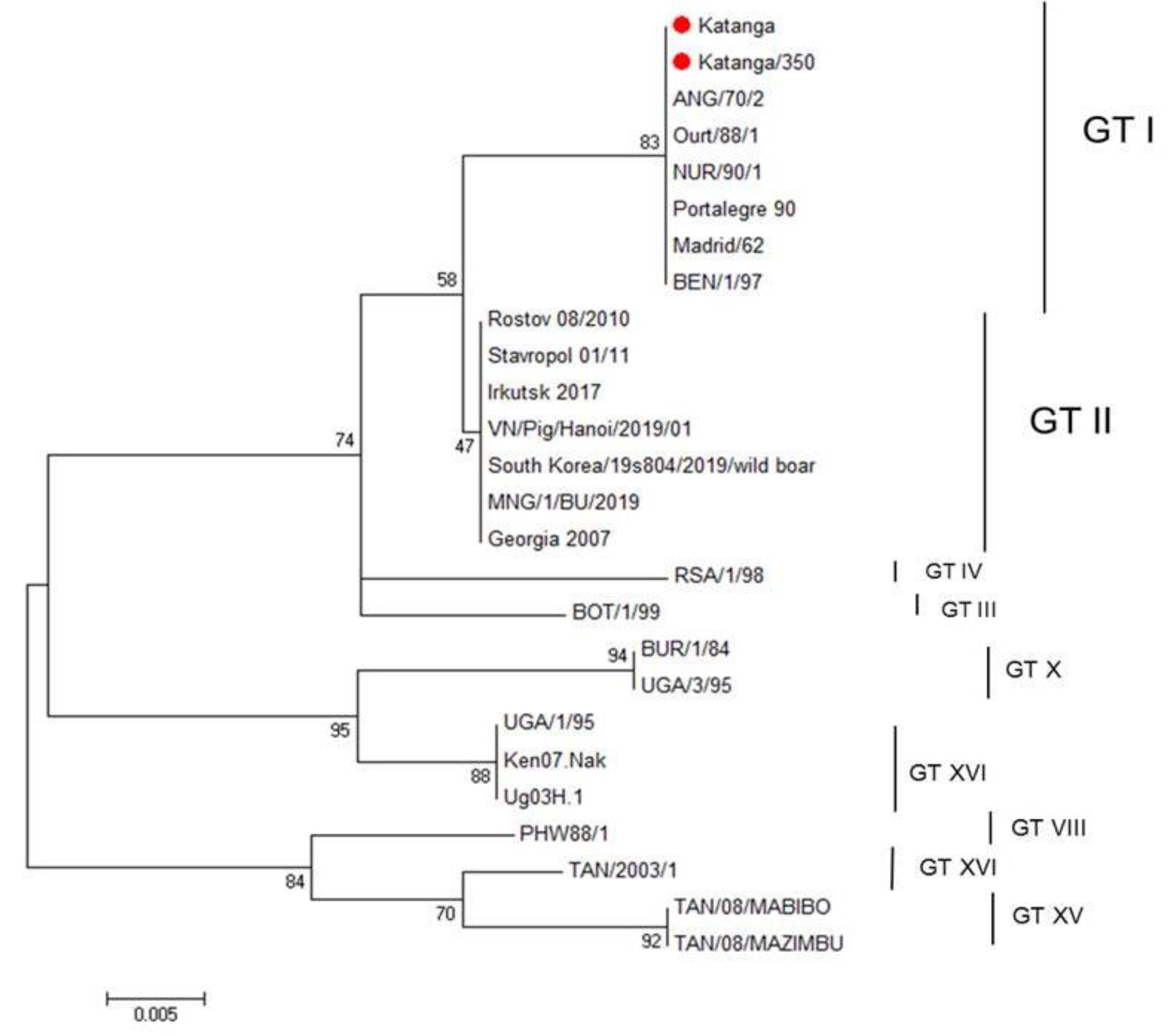
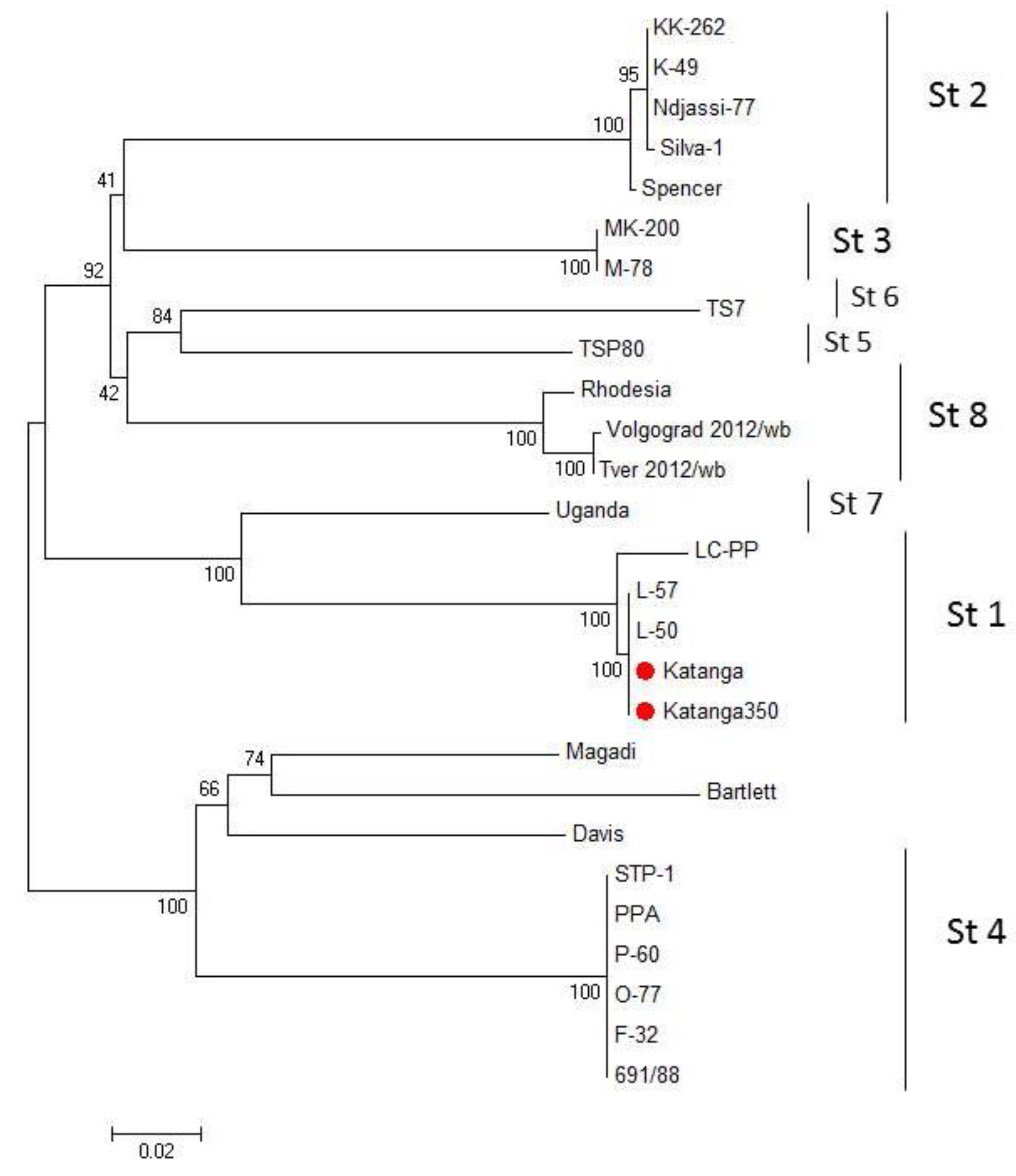
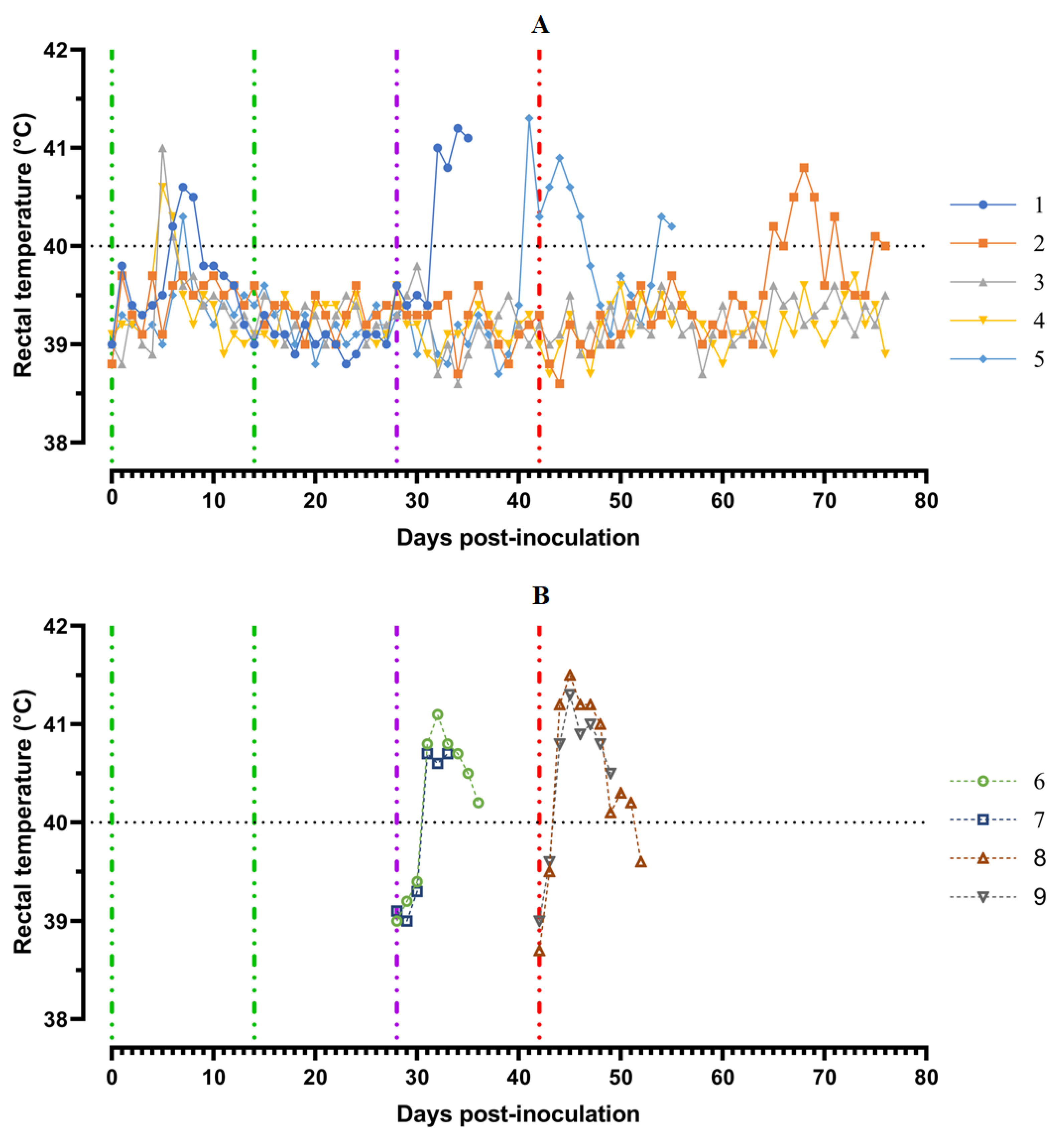


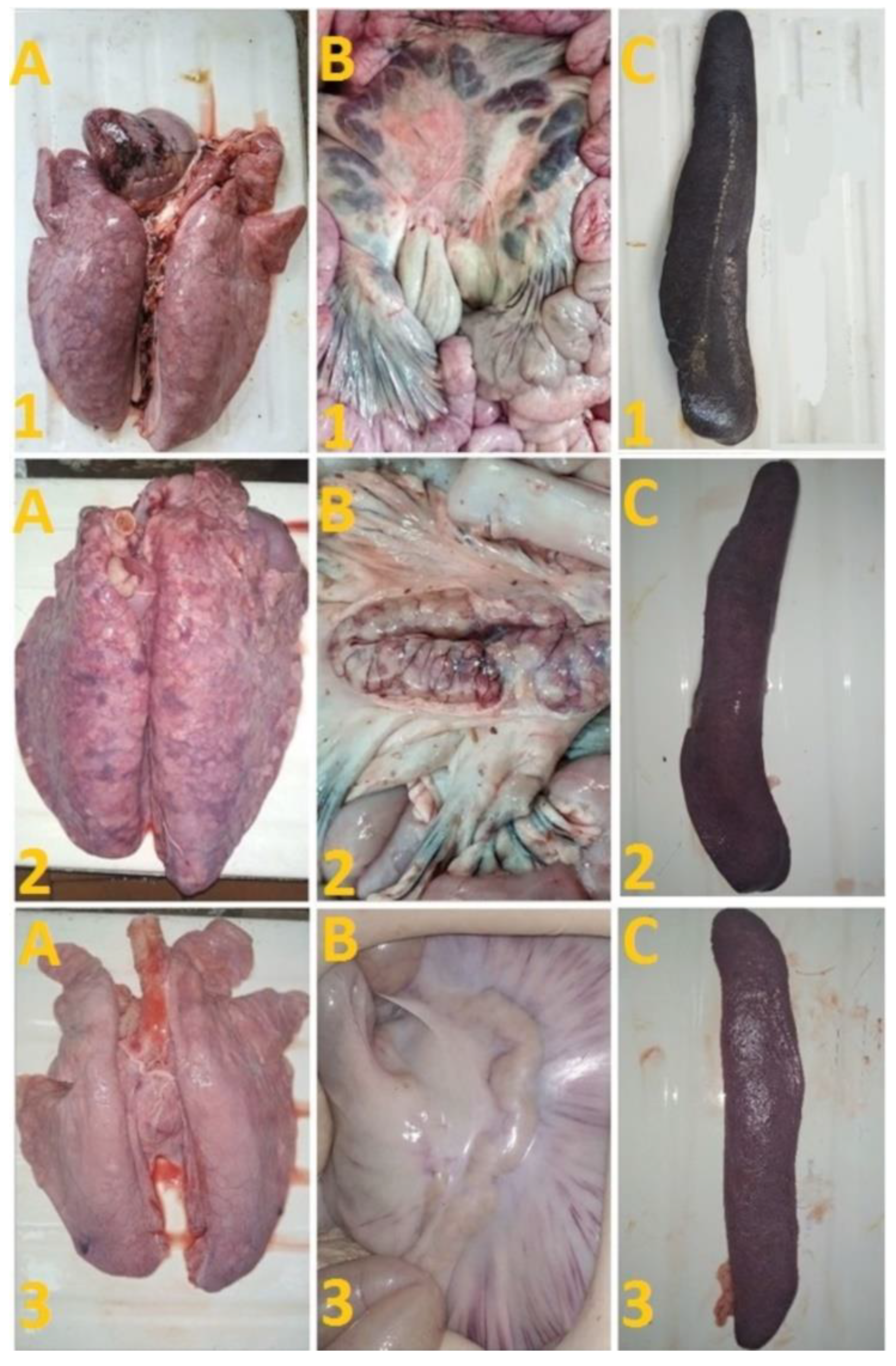
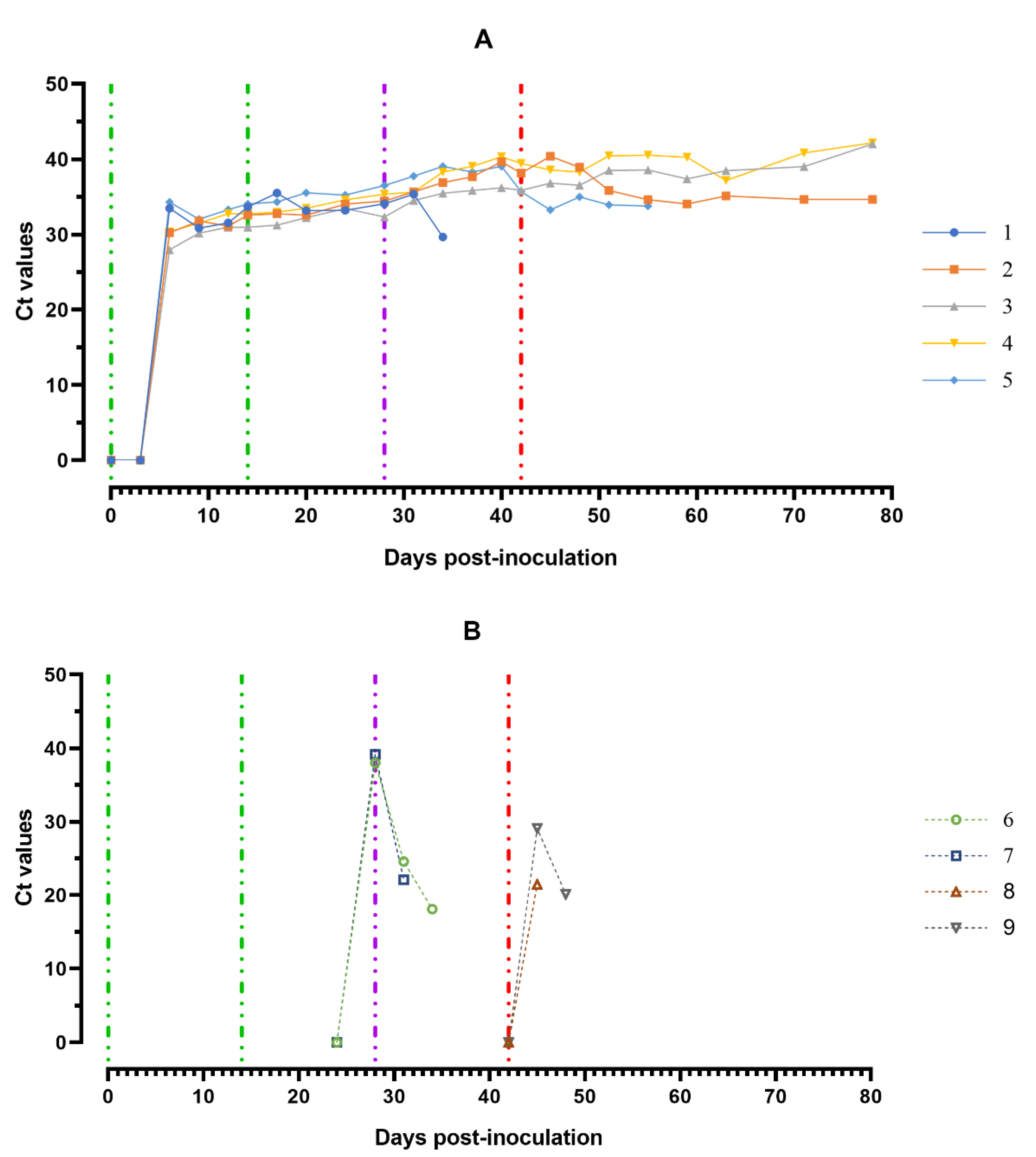
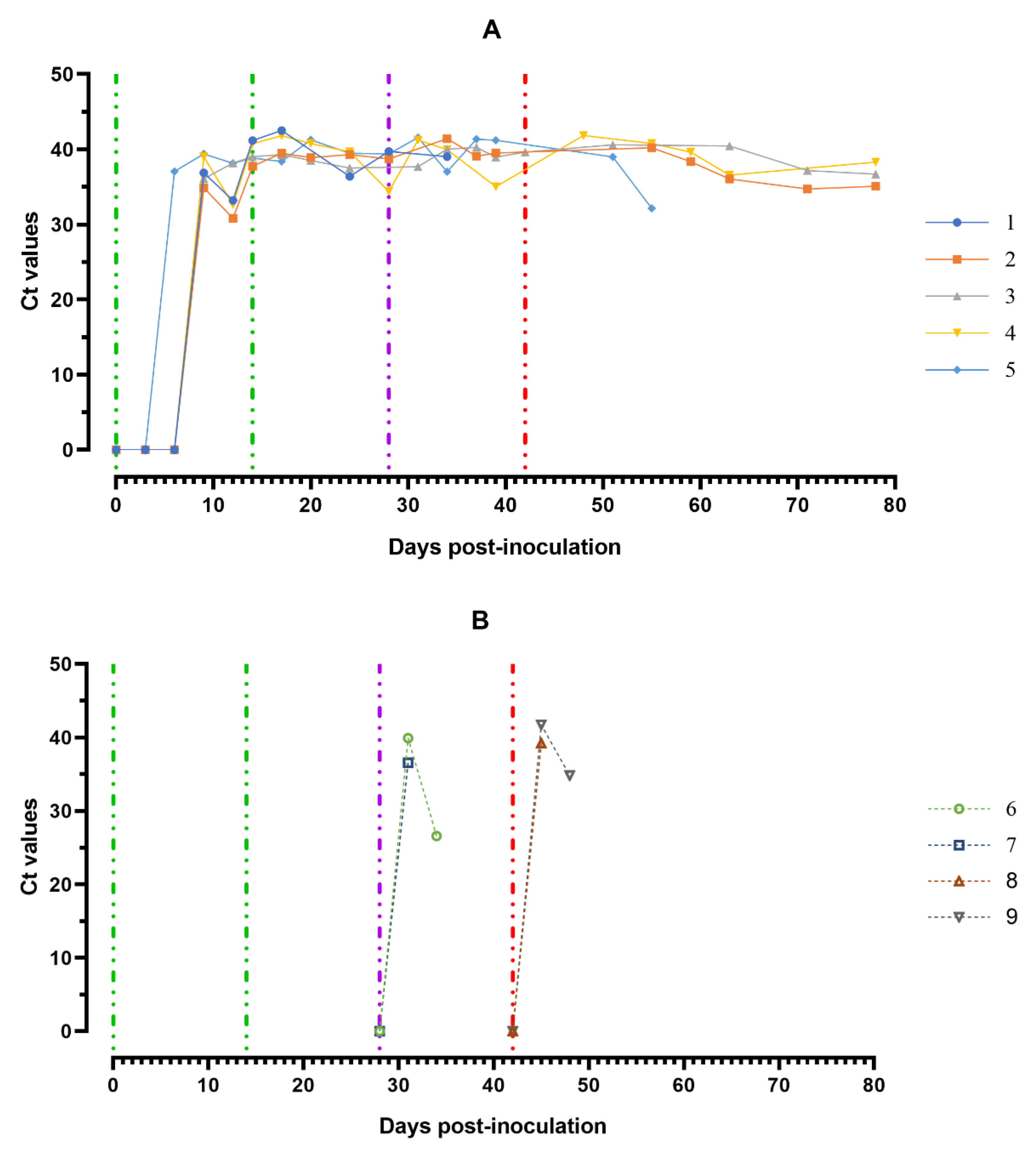

| Strains and Controls | Seroimmuno-Type | Serotype of Serum | Virus Control | ||||||||
|---|---|---|---|---|---|---|---|---|---|---|---|
| 1 | 2 | 3 | 4 | 5 | 6 | 7 | 8 | 9 | |||
| Lisbon-57 | I | −* | +** | + | + | + | + | + | + | + | + |
| Congo-49 | II | + | − | + | + | + | + | + | + | + | + |
| Mozambique–78 | III | + | + | − | + | + | + | + | + | + | + |
| France-32 | IV | + | + | + | − | + | + | + | + | + | + |
| TSP-80 | V | + | + | + | + | − | + | + | + | + | + |
| TS-7 | VI | + | + | + | + | + | − | + | + | + | + |
| Uganda | VII | + | + | + | + | + | + | − | + | + | + |
| Rhodesia | VIII | + | + | + | + | + | + | + | − | + | + |
| Davis | IX | + | + | + | + | + | + | + | + | − | + |
| Katanga | I | − | + | + | + | + | + | + | + | + | + |
| Katanga-350 | I | − | + | + | + | + | + | + | + | + | + |
| Stavropol 08/01 | VIII | + | + | + | + | + | + | + | − | + | + |
| Serum controls | n/a − | − | − | − | − | − | − | − | − | − | − |
| Cell culture control | n/a − | − | − | − | − | − | − | − | − | − | − |
| Group | Pig No. | Time, dpi | ||||||
|---|---|---|---|---|---|---|---|---|
| 0 | 14 | 28 | 29–41 | 42 | 43–77 | 78 | ||
| 1 | 1 | Katanga-350 | Katanga-350 | Lisbon-57 | Death day 36 | |||
| 2 | Katanga-350 | Katanga-350 | Lisbon-57 | Stavropol 08/01 | Chronic ASF 71–77 dpi | Euthanasia | ||
| 3 | Katanga-350 | Katanga-350 | Lisbon-57 | Stavropol 08/01 | Euthanasia | |||
| 4 | Katanga-350 | Katanga-350 | Lisbon-57 | Stavropol 08/01 | Euthanasia | |||
| 5 | Katanga-350 | Katanga-350 | Lisbon-57 | Chronic form ASF day 41–56 | Euthanasia day 56 | |||
| 2 | 6 | Lisbon-57 | Death day 34 | |||||
| 7 | Lisbon-57 | Death day 37 | ||||||
| 3 | 8 | Stavropol 08/01 | Death day 50 | |||||
| 9 | Stavropol 08/01 | Death day 50 | ||||||
Publisher’s Note: MDPI stays neutral with regard to jurisdictional claims in published maps and institutional affiliations. |
© 2022 by the authors. Licensee MDPI, Basel, Switzerland. This article is an open access article distributed under the terms and conditions of the Creative Commons Attribution (CC BY) license (https://creativecommons.org/licenses/by/4.0/).
Share and Cite
Sereda, A.D.; Vlasov, M.E.; Koltsova, G.S.; Morgunov, S.Y.; Kudrjashov, D.A.; Sindryakova, I.P.; Kolbasova, O.L.; Lyska, V.M.; Koltsov, A.Y.; Zhivoderov, S.P.; et al. Immunobiological Characteristics of the Attenuated African Swine Fever Virus Strain Katanga-350. Viruses 2022, 14, 1630. https://doi.org/10.3390/v14081630
Sereda AD, Vlasov ME, Koltsova GS, Morgunov SY, Kudrjashov DA, Sindryakova IP, Kolbasova OL, Lyska VM, Koltsov AY, Zhivoderov SP, et al. Immunobiological Characteristics of the Attenuated African Swine Fever Virus Strain Katanga-350. Viruses. 2022; 14(8):1630. https://doi.org/10.3390/v14081630
Chicago/Turabian StyleSereda, Alexey D., Mikhail E. Vlasov, Galina S. Koltsova, Sergey Y. Morgunov, Dmitry A. Kudrjashov, Irina P. Sindryakova, Olga L. Kolbasova, Valentina M. Lyska, Andrei Y. Koltsov, Sergey P. Zhivoderov, and et al. 2022. "Immunobiological Characteristics of the Attenuated African Swine Fever Virus Strain Katanga-350" Viruses 14, no. 8: 1630. https://doi.org/10.3390/v14081630







